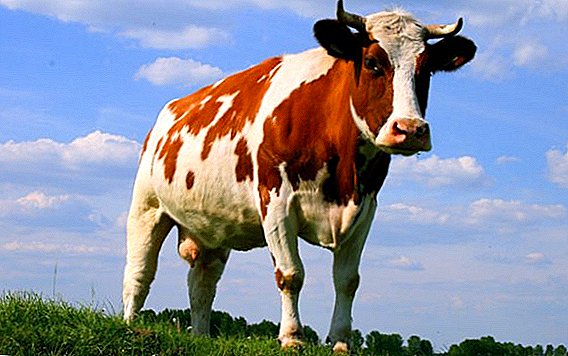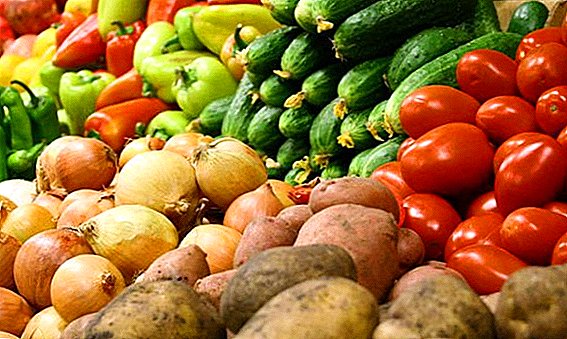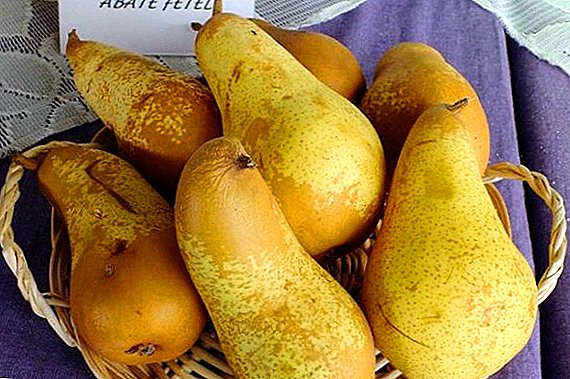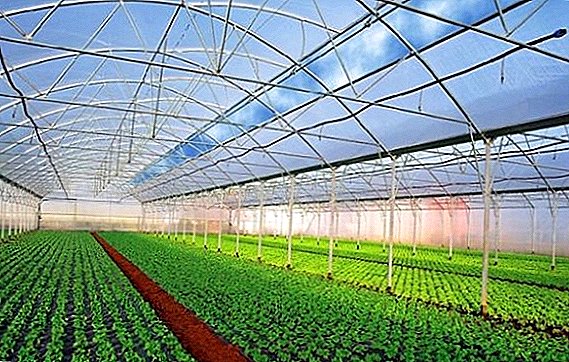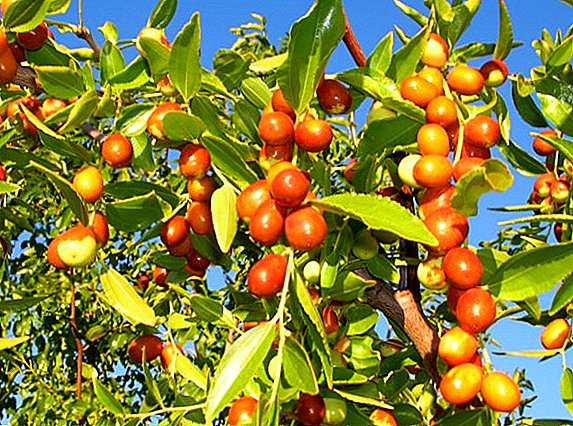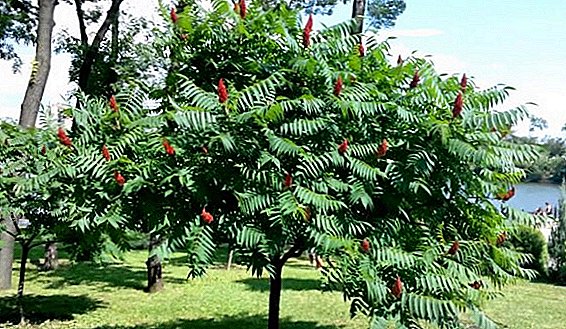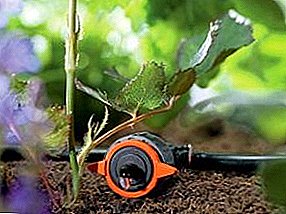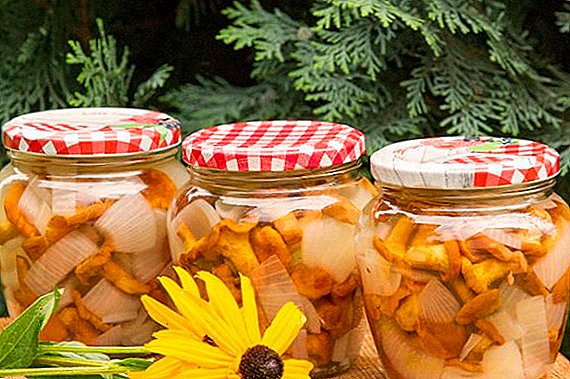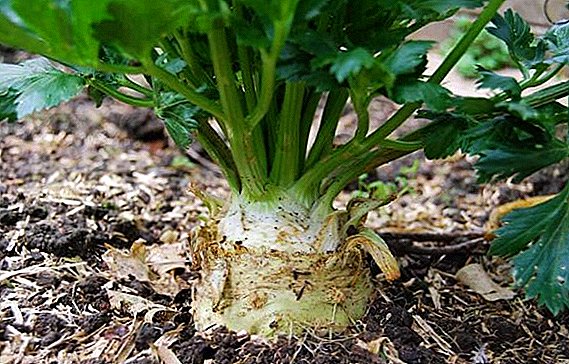 Celery root refers to plants with a long growing season. This feature often deters agronomists, but in practice it is not that difficult to grow celery at a dacha provided certain agricultural practices are observed. On the peculiarities of cultivation, as well as the basic rules for the care of celery, read below.
Celery root refers to plants with a long growing season. This feature often deters agronomists, but in practice it is not that difficult to grow celery at a dacha provided certain agricultural practices are observed. On the peculiarities of cultivation, as well as the basic rules for the care of celery, read below.
Features of celery root
Celery root belongs to two-year herbaceous and perennial crops of the Umbrella family. Mid-sized and large plants (up to 1 m tall) are characterized by a voluminous root system. Furrow-branched, erect stems end with pinnately dissected leaves that resemble parsley.
Greenish-white flowers are collected in complex inflorescences umbrellas. The main value of the plant is the root, although all parts of the plant are suitable for food. The root crop has a rounded shape, with a barely noticeable division into 2 parts. Its surface is rough, painted in greenish-gray color. On the cut, the flesh is white.  The cut celery fruits have white and fragrant pulp, which is excellent with potatoes in soups and mashed potatoes
The cut celery fruits have white and fragrant pulp, which is excellent with potatoes in soups and mashed potatoes
The plant prefers swampy soils and salt marshes. The main feature of the plant is not only a long growing season, but also a high need for moisture, which should be taken into account during cultivation. Celery has a high resistance to cold. The seedlings are able to tolerate frosts down to -5 ° C.
Did you know? Celery enhances male potency.
Planting and cultivation of celery seed
Before planting celery root type in the garden, you should choose the planting material. Seeds do not have a very high ability to germinate, due to the high content of esters in their composition, so gardeners use the seedless way rarely. When selecting planting material, special attention should be paid to the shelf life indicated on the package. The term should expire no earlier than one year from the date of purchase.
Longer-term storage of the crop and less fastidiousness in the care are characterized by mid-season varieties. They mature an average of 200 days.
The most fruitful, popular celery root varieties:
- Prague giant;

- Russian size;
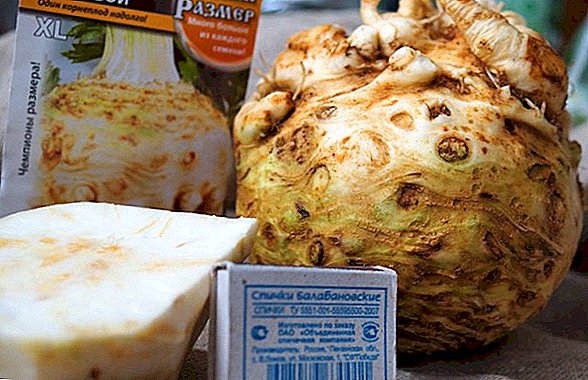
- Diamond;
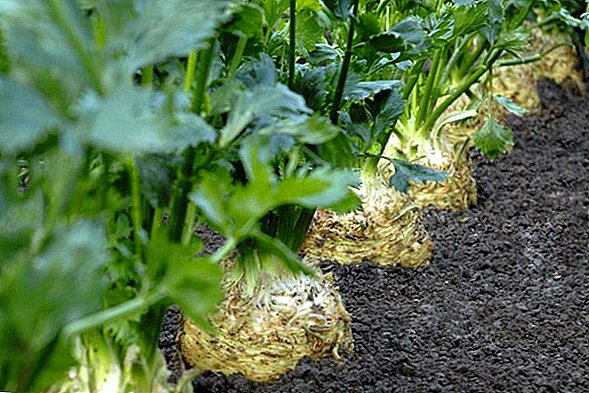
- The president.

Sowing seeds
Sow seeds on seedlings begin from February 5 to March 15. Before sowing the seeds need to be treated accordingly. This will help accelerate their germination and get a little harvest earlier. To begin with, the seeds should be soaked in a warm solution of potassium permanganate for 2-3 hours. On 250 ml of water add 1 g of manganese. Water temperature should be within + 35 ° С. After this treatment, the planting material should be moved to the “Epin” solution (2 drops / 100 ml of water) for 8-12 hours. Having passed these 2 stages, proceed to germination.
Did you know? Peat is a raw material for the production of drugs, and recently began to be used in SPA salons as the main raw material for a therapeutic bath.To do this, the seeds are wrapped in wet gauze. For 2-3 days in this state, the seeds are kept at a temperature of + 23 ... + 25 ° C, periodically moistening gauze as it dries. So that the seeds do not bloom from such an excess of water, you can lightly sprinkle them with crushed activated charcoal. Sow the seeds into general containers with a height of 10-15 cm and dimensions of 30 × 20 cm. The containers are pre-washed and disinfected with a solution of manganese.

For sowing seeds, prepare a substrate consisting of:
- peat;
- sand;
- leafy humus;
- soil for seedlings.
The components of the soil are mixed in the same proportions and treated with a solution of Fitosporin a week before sowing the seeds. The working solution is prepared on the basis of the ratio of 5:10.
We advise you to read about popular varieties of different types of celery.
When everything is ready, expanded clay is placed at the bottom of the container (layer height 1 cm). Then a well-moistened soil. On the surface of the soil make the grooves with a match. Their depth should be no more than 0.5 cm. Then spread the seeds at a distance of 4 cm from each other. Sprinkle planting material with a thin layer of soil 0.3-0.5 cm. The surface of the pot is covered with glass or polyethylene. Next, the pot is set aside in a dark place in which the air temperature is maintained within + 25 ° C.
Video: Sowing Celery Seed Seeds for Seedlings
Growing seedlings
On germination takes an average of 2-3 weeks. Before the emergence of shoots landing daily air, removing the shelter for 15 minutes. If necessary, moisten the soil with a spray.
With the emergence of seedlings need to rearrange the seedlings in a well-lit place. The air temperature is gradually reduced to + 16 ° C. Watering seedlings carried out on demand - the top layer of soil should be constantly wet, but not swampy. Moisturizing is carried out under the root of the spray, very carefully, so as not to damage the thin shoots.
Read also about the peculiarities of growing celery root seed from home.
Seedling care
As soon as sprouts form 2 true leaves, they are seated in separate containers. The best way to do this is to take peat pots - later, when transplanting into open ground, you do not have to injure the plants once more, but you can move them to the holes directly with the pots.
When picking into different pots, the main root is shortened by 1/3. Do this with sharp scissors, and then cut the cut with crushed activated charcoal. The first week after picking, the air temperature is maintained at + 23 ° C, and when the sprouts take root, they decrease to + 16 ° C. The air temperature at night is reduced to + 10 ... + 12 ° С. 
After 10-14 days after the picking make feeding. To do this, you can use "Appin" (3 drops of substance per 1 l of water). This feeding can be done 1-2 times before planting in open ground.
Watering and continue to carry out by spraying the soil from the spray. The optimal day length for seedlings is 10 hours.
1.5 weeks before transplantation into open ground, seedlings begin to harden. To do this, it is periodically taken out to an open balcony or garden, gradually increasing the time interval in the open air up to 24 hours.
Important! If the recommended temperature regime is not followed, the seedlings are strongly drawn out, which negatively affects the further ability of plants to form a tuber.
Planting celery in open ground
The final picking is carried out when the seedlings are at the age of 60-70 days, when there are 4-5 true leaves on the stems.
What time to plant
To root was large, in a hurry with a transplant is not worth it. It is best to carry out a picking in the middle of May, approximately in the 10-20th numbers. It is desirable that the average daily air temperature reaches a minimum of + 10 ° C. If you plant a crop earlier, then under the long-term influence of the low-temperature regime, it will enter the flowering phase in the first year of life, which will not allow forming a full-fledged root crop.
 For a larger root, do not rush to plant seedlings in open ground
For a larger root, do not rush to plant seedlings in open ground
Suitable soil
The most suitable for growing root celery are loamy soils enriched with plant humus and domesticated, well-fertilized peatlands.
A month before planting, deep loosening of the soil is carried out on the spade bayonet, rotten manure is introduced. A week before planting, watering with "Phytosporin" is carried out, which is diluted in a proportion of 5:10.
Rules and landing scheme
The standard planting scheme for root celery is 30 × 70 cm. Small-fruited varieties can be placed at a distance of 20 cm from each other, but it is better to leave more space.
We advise you to read about the properties of celery root.
The landing is carried out in the wells. Prepare landing pits for 2-3 hours before transplanting. The depth of the hole should correspond to the height of the glass in which the plant is located + 2-3 cm. After forming the wells, 0.5 liters of water at room temperature is poured into them.
If the sprouts are in plastic containers, then transplantation is carried out using the transshipment method while preserving the earthen coma. Plants in peat tanks are moved to the wells with them. The main thing - do not overdo it with the depth of the seedlings. You need to focus on the apical bud, from which the stems will grow. In no case can it be covered with soil. After transplantation, watering is carried out under the root. Each plant takes about 500 ml of water. After watering in a circle, mulching is carried out with dry ground.
 Seedlings best planted at a distance of 25-30 cm
Seedlings best planted at a distance of 25-30 cm
Features care for celery
Agrotechnology care for root celery is not too different from that for other garden crops, but it has several nuances that should be taken into account.
Important! During the whole period of celery growth, the stems should not be removed, otherwise the plants will form small roots.
How and what to water
The culture is demanding of moisture, so watering is done every 2-3 days, depending on weather conditions. The more natural rainfall, the less often you need to make water in the soil. In the dry summer months, watering is carried out daily. Bring water into the soil in the morning or evening. Watering can be done under the root or by sprinkling. The most correct option - a combination of these two methods of watering.
Water for irrigation can be taken from a water well, a well. There are no special requirements for the temperature of the water, it does not have to be heated before use.

How to fertilize celery
When deciding how to feed celery and how many times in a season to do this, it is worth considering that root crops are able to accumulate nitrates and do not grow very well with an excess of nitrogenous compounds in the soil.
Standard conduct 3 dressings:
- 15 days after transplantation;
- 20 days after the first;
- when the plant begins to form a head.
For the first time it is best to make an infusion on fresh green grass.. Add 10 kg of green to 20 liters of water. To speed up the reaction, you can add 30 g of powdered Fitosporin. The container is covered with a lid and insisted on a well-lit area for about a week, until the liquid begins to ferment. The resulting solution is drained, diluted with water 1: 0.5 and contribute 1 l to each plant. Overcooked greens are buried in the soil between the rows.
Video: Celery root feeding
The second feeding is carried out using a solution of wood ash. 500 g of ash are added to 10 liters of water, boil for 15 minutes. The resulting solution is drained, used for spraying the above-ground parts of plants and soil. This amount of solution is enough for processing 1 m². Ash can be used in dry form. In this case, it is powdered ground part and scattered on the soil. 400-500 g of ash are used for each m².
For the third time, you can use superphosphate.. In 10 liters of water add 1 tsp. fertilizer. This is enough for an area of 1 m². You can make a sheet or under the root.
We recommend to read about the features of the use of celery in diabetes.
How to weed celery
Weeding should begin immediately after planting in open ground and continue until harvest. The purpose of this event is to prevent the weeds from growing and to select the area of nutrition for celery.
Weeds should be removed along with the roots. It is best to do it with gloves on by hand. To facilitate the task itself, it is better to carry out this manipulation when the soil is wetted.
Video: Weeding celery beds
What is soil loosening for?
In parallel with the removal of weeds, the soil is loosened. Do not neglect this event. It is aimed at stabilizing the water-oxygen balance of the root systems. Frequent watering provoke a strong compaction of the soil, water is distributed unevenly and stagnates in the upper layer, not reaching the bottom of the root. In addition, after watering, a crust forms on the surface of the soil, which prevents the normal passage of air to the root.
After transplantation and for another month, the soil is loosened to a depth of 5 cm, then the depth increases by 2 times. As the root mass increases, its upper part will begin to bulge out of the soil. As soon as this happens, with each loosening of the root with a hoe, the soil is gradually raked off.
Important! Hilling is categorically contraindicated for celery root.
Mulching
The process of mulching the soil after irrigation and loosening allows you to retain moisture, which helps reduce the frequency of irrigation and provides reliable protection from weeds.
As mulch can be used:
- sawdust;
- straw;
- juicy green grass.

The height of the layer of mulch should be about 2-3 cm. During the process of weeding and loosening, part of the mulch will gradually be embedded in the soil, which will help to further enrich it with nutrients.
Did you know? In the works of Hippocrates, celery is described as a cure for diseases of the nerves. And indeed, due to the content of essential oils, the product has a relaxing effect on the central nervous system, improving the quality of sleep.
Diseases and pests of celery
The main diseases that can affect celery:
- Different types of rot - first of all it is necessary to reduce the amount of water introduced into the soil. Cut off the affected parts of the plant, if the roots are rotting, it is better to remove the plants from the garden bed. Process the cuts with activated carbon. To dust the plantations with wood ash in combination with Fundazol 1: 1.
- Virus mosaic and bacterial blotch - diseases caused by viruses are not subject to treatment. The affected specimens are removed from the bed and burned, and the remaining plants are treated with drugs that increase immunity. For example, Emochka-Fertility - 1 l of the drug is added to 30 l of water. Spray on the sheet and watering.

Among the pests for celery are dangerous:
- scoop - eliminated by dusting the plants with wood ash;

- carrot fly larva - eliminated by deep loosening in combination with dusting the soil and the plants with tobacco dust;
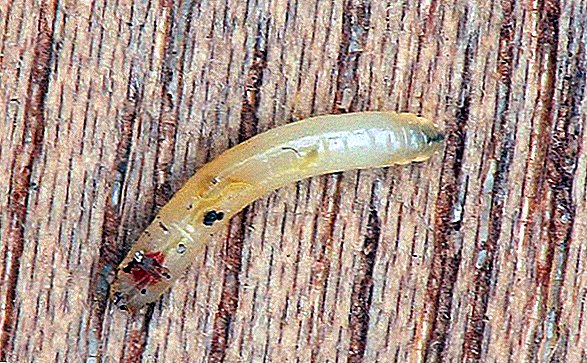
- snails and slugs - they can also be controlled by dusting the plants and the soil with ashes or tobacco dust.

If all the rules of agricultural engineering are observed, then the root celery is very rarely attacked by pests and the spread of disease. Prevention is the regular loosening of the soil and the timely application of fertilizers.
Harvesting and Storage
At the beginning of autumn, when additional thin roots will appear on the part of the root crop towering above the soil surface, it will be necessary to eliminate them with the help of scissors. You can also remove the lowermost stems. This will help the end of the growing season to form a beautiful tuber.
Learn more about how to keep celery for the winter at home.
The harvest begins in mid-October. It is at this point that the tuber accumulates the maximum amount of nutrients. It is better to dig up tubers in dry, windy weather. To make it easier to pull the root from the soil, with a shovel do a digging on one side, and then act manually. Having pulled a root from the soil, it is cleared of dirt manually. The fruits are left in the garden for 1-2 hours. Then cut off the entire ground part, leaving 2 cm tops.
You can store roots in the cellar or at home in a dark place. The optimum temperature for long-term storage of celery is 0 ... + 6 ° С. Humidity in the room should not be below 50%. The shelf life of root crops is 8-10 months.
Video: Harvesting and storing of celery root
Celery root belongs to unpretentious cultures. With the observance of the rules of agrotechnology, plants rarely infect pests and diseases, and the crop is maintained until the next planting.









